Brain injury cases can be especially complex due to the severe and often life-altering nature of the injuries. Demonstrating negligence in these cases is critical for achieving a successful outcome. Here’s a detailed guide to help you understand the key elements needed to establish negligence, the role of evidence, and effective legal strategies to build a strong brain injury case.
Contents
Duty of Care
The first step in establishing negligence is to show that the at-fault party had a duty of care towards the injured person. Duty of care refers to the legal obligation to act in a manner that avoids harm to others.
Drivers have a duty of care to operate their vehicles safely. Employers have a duty to provide a safe working environment. Healthcare providers must deliver care that meets established medical standards.
Breach of Duty
Once the duty of care is established, it must be shown that the at-fault party breached this duty. A breach occurs when the party fails to act as a reasonably prudent person would under similar circumstances. Examples include:
- Reckless driving: Opemitting at excessive speeds or ignoring traffic signals.
- Unsafe work conditions: Failure to follow safety protocols.
- Medical errors: Misdiagnosing a condition or surgical mistakes.
Causation
Proving causation involves demonstrating that the breach of duty directly caused the brain injury. This often requires establishing two elements; showing that the injury would not have occurred “but for” the defendant’s actions and demonstrating that the injury was a foreseeable result of the defendant’s actions.
Importance of Gathering Evidence
According to the Oakland accident attorneys at Milanfar Law Firm, solid evidence is crucial to establish the key elements of negligence in brain injury cases. Here are essential types of evidence that a lawyer may use to build a compelling case:
Medical Records
Medical records provide detailed information about the extent of the brain injury and the necessary treatments. They include:
- Diagnosis reports: Detailing the nature and scope of the brain injury.
- Treatment plans and progress notes: Documenting the medical care received and its effectiveness.
- Physician statements: Offering professional opinions on the cause and impact of the injury.
Expert Testimony
Expert witnesses are invaluable in brain injury cases due to the complex nature of these injuries. They can include:
- Medical experts: Physicians who specialize in neurology or brain injuries can testify about the cause and long-term effects of the injury.
- Accident reconstruction experts: These experts analyze the events leading up to the injury to establish causation.
Accident Reports
Accident reports by law enforcement or workplace safety inspectors can provide an objective account of the incident. They may include:
- Descriptions of the scene: Details on conditions or factors that contributed to the accident.
- Eyewitness statements: Accounts from individuals who observed the event.
Proving negligence in brain injury cases involves showing duty of care, breach of duty, causation, and damages. Strong evidence, including medical records and expert testimony, is crucial. This approach helps brain injury victims build solid cases and seek fair compensation for their injuries and ongoing care needs.




